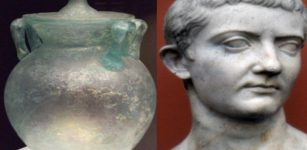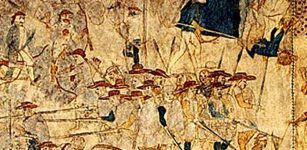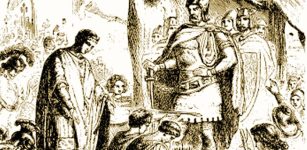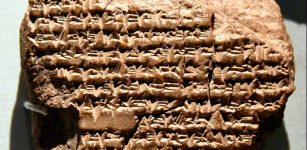Legendary Furies – Angry And Monstrous Women Of The Underworld
A. Sutherland - AncientPages.com - In Greek mythology, the Erinyes (also known as Furies) were three goddesses of revenge and retribution. The women resided in the underground world and were considered monstrous and evil.
Departing of Furies. Image credit: The Baldwin Project
These three sisters were called Alecto ("the angry"), Megaera ("the grudging"), and Tisiphone ("the avenger").
How the Furies were created remains unclear. According to one legend, they came from the blood of the Titan Uranus, when his son Cronus castrated him to take revenge for the loss of his siblings.
According to another legend, the Furies were Nyx's daughters, the night's symbolization, and a daughter of Chaos.
The "infernal goddesses" correspond to the Dirae in Roman mythology, and some suppose that they are called Furies in hell, Harpies on earth, and Dirae in heaven.
 Orestes at Delphi, flanked by Athena and Pylades, among the Erinyes and priestesses of the oracle. Paestan red-figure bell-krater, c. 330 BC. Python (as painter) - Jastrow (2006) - Public Domain
Orestes at Delphi, flanked by Athena and Pylades, among the Erinyes and priestesses of the oracle. Paestan red-figure bell-krater, c. 330 BC. Python (as painter) - Jastrow (2006) - Public Domain
Their appearance was remarkable and hideous. They had snakes for hair, dogs' heads, coal-black bodies, and bat wings. They had burning breath, and poisonous blood was dripping from their eyes. In their hands, they carry brass-studded scourges, and their victims die in torment.
The role of the Furies was to persecute crimes such as disrespect, injustice, perjury, arrogance, and, first and foremost- murder, especially the murder inside a family. The Furies were regarded as very evil because their lust for punishment knew no bounds, for they kept punishing a sinner even after his death until he finally showed remorse.
One of the most frequently repeated examples of ancient Greek literature featuring the Erinyes is found in examples that focus on the Orestes myth.
Orestes belonged to the third generation of the House of Atreus and was the last to suffer the curse of the Erinys, which plagued his house. As the story goes, Atreus and his brother Thyestes were rivals for the throne of Mycenae.
The Remorse of Orestes, where he is surrounded by the Erinyes. Image credit: William-Adolphe Bouguereau, 1862; Chrysler Museum of Art, Norfolk, Virginia
When Atreus won the throne, Thyestes conspired against him, seducing his wife to gain possession of a golden ram that would win him the kingdom.
But his sons, Agamemnon and Menelaus, drove him from the throne.
Atreus, however, returned from exile and regained his throne, expelling Thyestes. But, desiring a harsher penalty, he invited his brother back, murdered his two sons, and served them up before him as a meal. Later, Thyestes' son Aigisthos avenged this crime with the murder of Atreus.
When Agamemnon was away fighting the Trojan War, Aigisthos returned, seduced Agamemnon's queen Klytaimestra and conspired with her to murder the king upon his return. A curse fell upon the guilty pair, and his father's Erinys compelled the young Orestes to exact his vengeance.
Orestes himself was afterward plagued by the Erinys of his mother Klytaimestra for the crime of matricide until he was purified of the blood guilt by Apollo.
Erinyes are also Furies because their name in Greek mythology means "the angry ones."
Written by – A. Sutherland - AncientPages.com Senior Staff Writer
Updated on October 29, 2022
Copyright © AncientPages.com All rights reserved. This material may not be published, broadcast, rewritten or redistributed in whole or part without the express written permission of AncientPages.com
More From Ancient Pages
-
 Great Migrations Took Place In Poland And Ukraine In Bronze Age
Archaeology | Sep 8, 2023
Great Migrations Took Place In Poland And Ukraine In Bronze Age
Archaeology | Sep 8, 2023 -
 18th Century Potter Atmospheric Steam Engine Found In Slovakia
Archaeology | Jul 24, 2020
18th Century Potter Atmospheric Steam Engine Found In Slovakia
Archaeology | Jul 24, 2020 -
 Tomb Of Maia, Tutankhamun’s Wet Nurse In Egypt’s Saqqara Opens To Public
Archaeology | Dec 22, 2015
Tomb Of Maia, Tutankhamun’s Wet Nurse In Egypt’s Saqqara Opens To Public
Archaeology | Dec 22, 2015 -
 Flexible Glass – Lost Ancient Roman Invention Because Glassmaker Was Beheaded By Emperor Tiberius
Ancient Technology | Jul 27, 2023
Flexible Glass – Lost Ancient Roman Invention Because Glassmaker Was Beheaded By Emperor Tiberius
Ancient Technology | Jul 27, 2023 -
 Ship-Shaped Burial Of Tjelvar – Legendary First Man Who Brought Fire To Gotland
Featured Stories | Feb 25, 2021
Ship-Shaped Burial Of Tjelvar – Legendary First Man Who Brought Fire To Gotland
Featured Stories | Feb 25, 2021 -
 On This Day In History: Spanish Villasur Expedition Wiped Out By Pawnee And Otoe Warriors – On August 14, 1720
News | Aug 14, 2016
On This Day In History: Spanish Villasur Expedition Wiped Out By Pawnee And Otoe Warriors – On August 14, 1720
News | Aug 14, 2016 -
 Mysterious ‘Las Labradas’ Petroglyphs With Roots In The Pre-Columbian Times Of Mexico
Featured Stories | Oct 9, 2020
Mysterious ‘Las Labradas’ Petroglyphs With Roots In The Pre-Columbian Times Of Mexico
Featured Stories | Oct 9, 2020 -
 Why Were Actors Painted As Cats By Ukiyo-e Artists In Japan?
Ancient History Facts | Feb 11, 2020
Why Were Actors Painted As Cats By Ukiyo-e Artists In Japan?
Ancient History Facts | Feb 11, 2020 -
 Did Leonardo Da Vinci Invent Contact Lenses In 1508?
Ancient Technology | Dec 10, 2015
Did Leonardo Da Vinci Invent Contact Lenses In 1508?
Ancient Technology | Dec 10, 2015 -
 Hades – ‘The Unseen’ God Of The Dead, Fertility, Wealth And Earth’s Minerals
Featured Stories | Jun 2, 2020
Hades – ‘The Unseen’ God Of The Dead, Fertility, Wealth And Earth’s Minerals
Featured Stories | Jun 2, 2020 -
 Yenikapı Shipwrecks – A Unique Historical Treasure That Sheds Light On Ancient Ship Production
Archaeology | Oct 28, 2015
Yenikapı Shipwrecks – A Unique Historical Treasure That Sheds Light On Ancient Ship Production
Archaeology | Oct 28, 2015 -
 Ars Amatoria – Ancient Roman Flirting Tips – Could They Still Work?
Featured Stories | Mar 26, 2019
Ars Amatoria – Ancient Roman Flirting Tips – Could They Still Work?
Featured Stories | Mar 26, 2019 -
 On This Day In History: Emperor Romulus Augustus Deposed – On September 4, 476
News | Sep 4, 2016
On This Day In History: Emperor Romulus Augustus Deposed – On September 4, 476
News | Sep 4, 2016 -
 Many Roman Citizens Joined The Huns And Preferred Their Nomadic Lifestyle – New Study
Archaeology | Apr 4, 2017
Many Roman Citizens Joined The Huns And Preferred Their Nomadic Lifestyle – New Study
Archaeology | Apr 4, 2017 -
 10 Mysterious Ancient Stones In North America That Could Re-Write History
Civilizations | May 25, 2020
10 Mysterious Ancient Stones In North America That Could Re-Write History
Civilizations | May 25, 2020 -
 World’s First ‘Cash Machine’ Discovered In A Wall Of An Ancient Bakery
Archaeology | Apr 1, 2022
World’s First ‘Cash Machine’ Discovered In A Wall Of An Ancient Bakery
Archaeology | Apr 1, 2022 -
 On This Day In History: Battle Of Gaugamela – Alexander The Great Defeats Darius III Of Persia – On Oct 1, 331 BC
News | Oct 1, 2016
On This Day In History: Battle Of Gaugamela – Alexander The Great Defeats Darius III Of Persia – On Oct 1, 331 BC
News | Oct 1, 2016 -
 Long-Lost Roman Bridge Re-Discovered In Chepstow River Wye Mud, UK
Archaeology | Aug 12, 2023
Long-Lost Roman Bridge Re-Discovered In Chepstow River Wye Mud, UK
Archaeology | Aug 12, 2023 -
 World’s Oldest Marine Navigation Tool Was A Sophisticated Astrolabe
Archaeology | Oct 25, 2017
World’s Oldest Marine Navigation Tool Was A Sophisticated Astrolabe
Archaeology | Oct 25, 2017 -
 On This Day In History: Antarctic Explorer Lawrence “Titus” Oates Born – On Mar 17, 1880
News | Mar 17, 2017
On This Day In History: Antarctic Explorer Lawrence “Titus” Oates Born – On Mar 17, 1880
News | Mar 17, 2017


